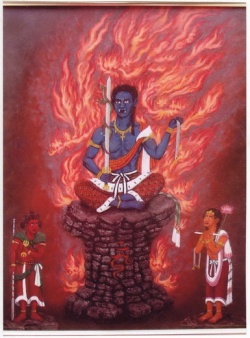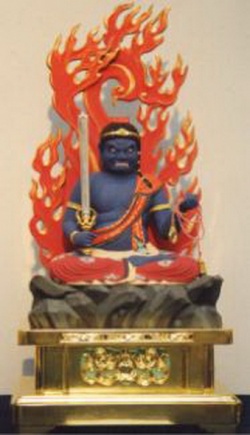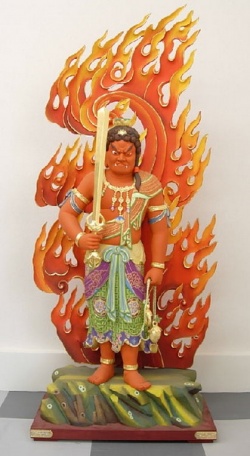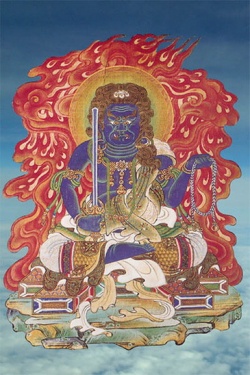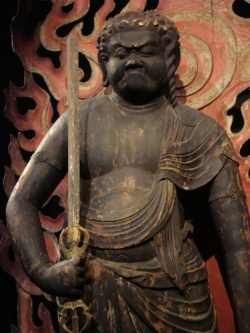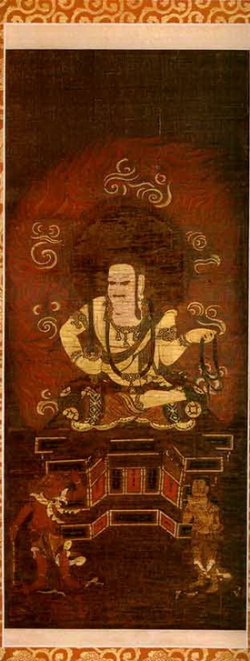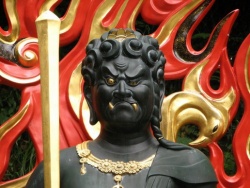Difference between revisions of "Achala"
| Line 4: | Line 4: | ||
[[Acalanatha]] (a [[Vidyarajas]]) ({{Wiki|Chinese}}: [[Pu tung]]; [[Japanese]]: [[Fudo]]) | [[Acalanatha]] (a [[Vidyarajas]]) ({{Wiki|Chinese}}: [[Pu tung]]; [[Japanese]]: [[Fudo]]) | ||
| + | |||
[[Fudō]] Jap. [[name]] for [[Acala]] (q.v.), a [[manifestation]] of [[Dainichi]] ([[Vairocana]], q.v.). Popular [[subject]] for Jap. painting and {{Wiki|sculpture}}, adopted into Bsm. as one of [[five Myōō]], [[manifestations]] of the [[five Nyorai]] (q.v.). | [[Fudō]] Jap. [[name]] for [[Acala]] (q.v.), a [[manifestation]] of [[Dainichi]] ([[Vairocana]], q.v.). Popular [[subject]] for Jap. painting and {{Wiki|sculpture}}, adopted into Bsm. as one of [[five Myōō]], [[manifestations]] of the [[five Nyorai]] (q.v.). | ||
| Line 24: | Line 25: | ||
[[Immovable]]<br/> | [[Immovable]]<br/> | ||
[[不動明王]] (Skt [[Achala]] or [[Achalanatha]]; Jpn [[Fudo-myo’o]]) | [[不動明王]] (Skt [[Achala]] or [[Achalanatha]]; Jpn [[Fudo-myo’o]]) | ||
| + | |||
(1) The [[wisdom king]] [[Immovable]]. [[Immovable]] is a main [[deity]] among the [[wisdom kings]], a group of [[deities]] who are said to remove all [[obstacles]] and defeat all [[devils]] that hinder [[Buddhist]] practice.He is regarded as the leader of the [[five great wisdom kings]], the other four being | (1) The [[wisdom king]] [[Immovable]]. [[Immovable]] is a main [[deity]] among the [[wisdom kings]], a group of [[deities]] who are said to remove all [[obstacles]] and defeat all [[devils]] that hinder [[Buddhist]] practice.He is regarded as the leader of the [[five great wisdom kings]], the other four being | ||
| Line 34: | Line 36: | ||
(3)[[不動智仏]](Jpn [[Fudochi-butsu]]): The [[Buddha Immovable]]. A shortened [[name]] for the [[Buddha Immovable Wisdom]]. | (3)[[不動智仏]](Jpn [[Fudochi-butsu]]): The [[Buddha Immovable]]. A shortened [[name]] for the [[Buddha Immovable Wisdom]]. | ||
| + | |||
See [[Immovable Wisdom]] | See [[Immovable Wisdom]] | ||
| Line 52: | Line 55: | ||
[[Mystical]] [[Knowledge]], [[Kings]] of [[Light]]) of the [[Womb Realm]]. The [[Sanskrit]] term [[ācala]] means “[[immovable]]”; [[Ācala]] is also the [[name]] of the eighth of the ten completion stages of the [[Bodhisattva path]] (the [[Eighth Bhumi]]). His [[siddham]] seed-syllabe is “[[hāṃ]]”. He is one of the [[Krodharajas]], the [[Lords]] of [[Wrath]]. | [[Mystical]] [[Knowledge]], [[Kings]] of [[Light]]) of the [[Womb Realm]]. The [[Sanskrit]] term [[ācala]] means “[[immovable]]”; [[Ācala]] is also the [[name]] of the eighth of the ten completion stages of the [[Bodhisattva path]] (the [[Eighth Bhumi]]). His [[siddham]] seed-syllabe is “[[hāṃ]]”. He is one of the [[Krodharajas]], the [[Lords]] of [[Wrath]]. | ||
| + | |||
He is considered as a [[body]] of {{Wiki|metamorphosis}} ([[Nirmanakaya]]) of [[Vairocana]] [[Buddha]]. He is the [[symbolic]] [[protector]] of [[Buddhism]], [[essentially]] [[incarnating]] [[Prajna]] [[Immovable]] for [[sentient beings]]. | He is considered as a [[body]] of {{Wiki|metamorphosis}} ([[Nirmanakaya]]) of [[Vairocana]] [[Buddha]]. He is the [[symbolic]] [[protector]] of [[Buddhism]], [[essentially]] [[incarnating]] [[Prajna]] [[Immovable]] for [[sentient beings]]. | ||
| Line 60: | Line 64: | ||
[[Acala]] is mentioned extensively in The [[Vairocanābhisaṃbodhi Sutra]] ([[Mahāvairocana-abhisaṃbodhi-tantra]]), as follows: | [[Acala]] is mentioned extensively in The [[Vairocanābhisaṃbodhi Sutra]] ([[Mahāvairocana-abhisaṃbodhi-tantra]]), as follows: | ||
| + | |||
: Fascicle One, “Below the mantra-lord (i.e., [[Vairocana]]), in the [[direction]] of [[Nairṛti]] (i.e., [[southwest]]), Is [[Acala]], the [[Tathāgata’s]] servant: he holds a [[wisdom]] sword and a noose, The [[hair]] from the top of his head hangs down on his left shoulder, and with one [[eye]] he looks fixedly; Awesomely [[wrathful]], his [[body]] [is enveloped in] fierce flames, and he rests on a rock; His face is marked with [a frown like] waves on [[water]], and he has the figure of a stout young boy.” | : Fascicle One, “Below the mantra-lord (i.e., [[Vairocana]]), in the [[direction]] of [[Nairṛti]] (i.e., [[southwest]]), Is [[Acala]], the [[Tathāgata’s]] servant: he holds a [[wisdom]] sword and a noose, The [[hair]] from the top of his head hangs down on his left shoulder, and with one [[eye]] he looks fixedly; Awesomely [[wrathful]], his [[body]] [is enveloped in] fierce flames, and he rests on a rock; His face is marked with [a frown like] waves on [[water]], and he has the figure of a stout young boy.” | ||
| Line 68: | Line 73: | ||
: Fascicle Four, “Make a fist with the left hand, extend the middle finger and forefinger, and place the thumb on top of the little and ring fingers; extend the forefinger and middle finger of the right hand, insert them in the left palm, and again place the thumb on top of the little and ring fingers, just like in the sheath of a sword: this is the {{Wiki|seal}} of [[Acalanātha]].” | : Fascicle Four, “Make a fist with the left hand, extend the middle finger and forefinger, and place the thumb on top of the little and ring fingers; extend the forefinger and middle finger of the right hand, insert them in the left palm, and again place the thumb on top of the little and ring fingers, just like in the sheath of a sword: this is the {{Wiki|seal}} of [[Acalanātha]].” | ||
| + | |||
: Fascicle Five, “The [[maṇḍala]] of [[Acala]] has both a circle of [[wind]] and of [[fire]]; He is in the [[direction]] of [[Nairṛti]] (i.e., [[southwest]]), below the [[Tathāgata]] [[Vairocana]], Surrounded by seed[-{{Wiki|syllables}}], and a [[sublime]] great [[wisdom]] sword, Or a noose {{Wiki|seal}} he who possesses [[wisdom]] lays out.” | : Fascicle Five, “The [[maṇḍala]] of [[Acala]] has both a circle of [[wind]] and of [[fire]]; He is in the [[direction]] of [[Nairṛti]] (i.e., [[southwest]]), below the [[Tathāgata]] [[Vairocana]], Surrounded by seed[-{{Wiki|syllables}}], and a [[sublime]] great [[wisdom]] sword, Or a noose {{Wiki|seal}} he who possesses [[wisdom]] lays out.” | ||
| Line 77: | Line 83: | ||
fangs, one pointing upward and other pointing downward. Fudō’s aureole is typically the flames of [[fire]], which according to [[Buddhist]] lore, represent the [[purification]] of the [[mind]] by the burning away of all {{Wiki|material}} [[desires]]. In some [[Japanese]] {{Wiki|sculpture}}, [[Fudō]] is flanked by two {{Wiki|attendants}}, [[Kongara Dōji]] and [[Seitaka Dōji]].” | fangs, one pointing upward and other pointing downward. Fudō’s aureole is typically the flames of [[fire]], which according to [[Buddhist]] lore, represent the [[purification]] of the [[mind]] by the burning away of all {{Wiki|material}} [[desires]]. In some [[Japanese]] {{Wiki|sculpture}}, [[Fudō]] is flanked by two {{Wiki|attendants}}, [[Kongara Dōji]] and [[Seitaka Dōji]].” | ||
| + | |||
====[[Mantra]]==== | ====[[Mantra]]==== | ||
| + | |||
Fascicle Two, “[[Acalanātha]]: [[Namaḥ]] [[samanta]] vajrāṇāṃ, [[caṇḍamahāroṣaṇa]] spho-ṭaya [[hūṃ]] traka [[hāṃ]] māṃ. (Homage to all [[Vajras]]! O you who are [[violent]] andvery [[wrathful]]! rend! [[hūṃ]] traka [[hāṃ]] māṃ!)” | Fascicle Two, “[[Acalanātha]]: [[Namaḥ]] [[samanta]] vajrāṇāṃ, [[caṇḍamahāroṣaṇa]] spho-ṭaya [[hūṃ]] traka [[hāṃ]] māṃ. (Homage to all [[Vajras]]! O you who are [[violent]] andvery [[wrathful]]! rend! [[hūṃ]] traka [[hāṃ]] māṃ!)” | ||
The [[mantra]] of [[Acalanātha]]: [[Namaḥ samantavajrāṇāṃ, hāṃ]]. (Homage to all [[Vajras]]! Hāṃ!) | The [[mantra]] of [[Acalanātha]]: [[Namaḥ samantavajrāṇāṃ, hāṃ]]. (Homage to all [[Vajras]]! Hāṃ!) | ||
| + | |||
===About [[Kumaras]] === | ===About [[Kumaras]] === | ||
| + | |||
[[Acala]] or [[Kulikah]] is usually flanked by two [[kumaras]] or mahakumaras (child {{Wiki|attendants}} or {{Wiki|acolytes}}), [[Kimkara]] ([[Kinkara]], [[Japanese]]: [[Kongara Doji]]) and [[Cetaka]] ([[Japanese]]: [[Seitaka]] [[Doji]]). [[Kumaras]] are [[divine]] boys between the ages of 8 and 20, who serve as | [[Acala]] or [[Kulikah]] is usually flanked by two [[kumaras]] or mahakumaras (child {{Wiki|attendants}} or {{Wiki|acolytes}}), [[Kimkara]] ([[Kinkara]], [[Japanese]]: [[Kongara Doji]]) and [[Cetaka]] ([[Japanese]]: [[Seitaka]] [[Doji]]). [[Kumaras]] are [[divine]] boys between the ages of 8 and 20, who serve as | ||
| Line 93: | Line 103: | ||
[[heavenly]] [[robes]]. [[Kimkara]] is usually depicted in pale white {{Wiki|skin}} {{Wiki|colour}}, [[an embodiment]] of [[compassion]] to worshippers of [[Acalanatha]], while [[Cetaka]] is depicted in [[red]] {{Wiki|skin}} {{Wiki|colour}}, an indication of his [[wrath]] to [[discipline]] erring followers in mending their ways. | [[heavenly]] [[robes]]. [[Kimkara]] is usually depicted in pale white {{Wiki|skin}} {{Wiki|colour}}, [[an embodiment]] of [[compassion]] to worshippers of [[Acalanatha]], while [[Cetaka]] is depicted in [[red]] {{Wiki|skin}} {{Wiki|colour}}, an indication of his [[wrath]] to [[discipline]] erring followers in mending their ways. | ||
| + | |||
====[[Art]]==== | ====[[Art]]==== | ||
| + | |||
He usually holds in his right hand a double-edged sword with a three-pointed [[vajra]] handle vertically (to combat the 3 [[poisons]] – [[greed]], [[anger]] and [[ignorance]]) which [[winds]] a [[dragon]] surrounded by flames and in his left hand a rope lariat or lasso with a hook or two pointed varja at each end | He usually holds in his right hand a double-edged sword with a three-pointed [[vajra]] handle vertically (to combat the 3 [[poisons]] – [[greed]], [[anger]] and [[ignorance]]) which [[winds]] a [[dragon]] surrounded by flames and in his left hand a rope lariat or lasso with a hook or two pointed varja at each end | ||
| Line 117: | Line 129: | ||
[http://www.btrts.org.sg/temple-first-kulikah btrts.org.sg] | [http://www.btrts.org.sg/temple-first-kulikah btrts.org.sg] | ||
{{NewSourceBreak}} | {{NewSourceBreak}} | ||
| + | |||
In [[Vajrayana Buddhism]], [[Ācala]] or [[Achala]] ("The [[Immovable One]]" in [[Sanskrit]], [[阿遮羅]], [[Zh Āzhēluó]], Jp [[Achara]]), also known as [[Āryācalanātha]], [[Ācala-vidyā-rāja]] and [[Caṇḍamahāroṣaṇa]] as well as [[Fudō myō-ō]] ([[不動明王]] Zh [[budongmingwang]]) in [[Japanese]], is the best known of the [[Five Wisdom Kings]] of the [[Womb Realm]]. [[Acala]] is also the eighth of the [[ten stages]] towards [[Buddhahood]]. | In [[Vajrayana Buddhism]], [[Ācala]] or [[Achala]] ("The [[Immovable One]]" in [[Sanskrit]], [[阿遮羅]], [[Zh Āzhēluó]], Jp [[Achara]]), also known as [[Āryācalanātha]], [[Ācala-vidyā-rāja]] and [[Caṇḍamahāroṣaṇa]] as well as [[Fudō myō-ō]] ([[不動明王]] Zh [[budongmingwang]]) in [[Japanese]], is the best known of the [[Five Wisdom Kings]] of the [[Womb Realm]]. [[Acala]] is also the eighth of the [[ten stages]] towards [[Buddhahood]]. | ||
| Line 125: | Line 138: | ||
The [[Buddha Akshobhya]], whose [[name]] in [[Sanskrit]] also means '[[Immovable One]]', is sometimes merged with [[Acala]]. However, [[Acalanatha]] is not a [[Buddha]], but one of the [[Five Wisdom Kings]] of the [[Womb Realm]] in [[Vajrayana]] as found in the [[Indo-Tibetan]] [[tradition]], as well as the [[Japanese]] [[Shingon]] [[sect]] of [[Buddhism]]. As [[Fudō myō-ō]], [[Acala]] is considered one of the [[Thirteen Buddhas]] in [[Japan]]. | The [[Buddha Akshobhya]], whose [[name]] in [[Sanskrit]] also means '[[Immovable One]]', is sometimes merged with [[Acala]]. However, [[Acalanatha]] is not a [[Buddha]], but one of the [[Five Wisdom Kings]] of the [[Womb Realm]] in [[Vajrayana]] as found in the [[Indo-Tibetan]] [[tradition]], as well as the [[Japanese]] [[Shingon]] [[sect]] of [[Buddhism]]. As [[Fudō myō-ō]], [[Acala]] is considered one of the [[Thirteen Buddhas]] in [[Japan]]. | ||
| + | |||
==={{Wiki|Iconography}}=== | ==={{Wiki|Iconography}}=== | ||
| + | |||
[[Acala]] is typically depicted with a sword for subduing [[demons]] in his right hand and a rope for catching and binding them in his left hand. He has a fearsome blue visage and is surrounded by flames, representing the [[purification]] of the [[mind]]. He is often depicted seated or [[standing]] on a rock to | [[Acala]] is typically depicted with a sword for subduing [[demons]] in his right hand and a rope for catching and binding them in his left hand. He has a fearsome blue visage and is surrounded by flames, representing the [[purification]] of the [[mind]]. He is often depicted seated or [[standing]] on a rock to | ||
Revision as of 11:19, 15 November 2020
Acalanatha (a Vidyarajas) (Chinese: Pu tung; Japanese: Fudo)
Fudō Jap. name for Acala (q.v.), a manifestation of Dainichi (Vairocana, q.v.). Popular subject for Jap. painting and sculpture, adopted into Bsm. as one of five Myōō, manifestations of the five Nyorai (q.v.).
Achala (Wyl. mi g.yo ba) is one of the ten wrathful kings and one of the main meditational deities of the Kadampa school.
Source
不動明王 (Skt; Jpn Fudo-myo’o)
The wisdom king Immovable, regarded as the head of the five great wisdom kings.
Source
Immovable
不動明王 (Skt Achala or Achalanatha; Jpn Fudo-myo’o)
(1) The wisdom king Immovable. Immovable is a main deity among the wisdom kings, a group of deities who are said to remove all obstacles and defeat all devils that hinder Buddhist practice.He is regarded as the leader of the five great wisdom kings, the other four being
Conqueror of the Threefold World, Kundali, Great Awesome Virtue, and Diamond Yaksha, as well as of the eight great wisdom kings (the above five deities plus Ucchushma, Unconquerable, and Horse-Headed).It is said that he enters the flame-emitting meditation in which he emits flames that
destroy all karmic hindrances.Because he remains unperturbed by obstacles, he is called Immovable.He is popularly depicted as an angry figure surrounded by flames, holding a rope and a sword.The Sanskrit name achala means immovable, and natha means a lord or a protector.See also flame-emitting meditation.
(2)不動仏(Jpn Fudo-butsu): The Buddha Immovable, also known as Akshobhya Buddha. See Akshobhya.
(3)不動智仏(Jpn Fudochi-butsu): The Buddha Immovable. A shortened name for the Buddha Immovable Wisdom.
See Immovable Wisdom
Source
Fudo Myoo has the power to destroy obstacles to Buddhism and acts under orders from Dainishi Nyorai. Therefore, it is also known as Fudo Shisha (envoy). Fudo Myoo also has envoys known as Hachidai Doji (eight Doji) including two Doji, Kongara and Seitaka. The Fudo in this painting is considered to have been established by Gensho from Asukadera Temple in the Heian period and the styles follow those that became popular thereafter. Hachidai Doji is a set of Doji that was newly created by adding some changes to each one from various origins. The compositions created by these combined features seem to be original. Halos with flames of Fudo are skillfully designed and shaped in three sacred birds called Karura and the characteristic of Fudo that burns down all obstacles is enhanced by using the twist of surrounding everything, including the Hachidai Doji, with flames. As there is no evidence of drafting the part of the flames surrounding Doji, they are
considered to have been added at the time of coloring along with the intended expressions. This is one of the indications of the creativity of this painting. The images are drawn with accurate brush strokes in ink and a careful attempt was made to keep these features relatively simple by coloring them without applying many gold or silver patterns, which makes this painting distinctive.
Source
Ācala or Achala (Sanskrit: Achala or Acalanātha (अचलनाथ) in; Āryācalanātha, Ācala-vidyā-rāja and Caṇḍamahāroṣaṇa; Chinese:不動明王, Búdòng Míngwáng; Japanese: 不動明王, Fudo Myo-O, Joju Kongo, Mongolian: Хөдөлшгүй: Tibetan: མི་གཡོ་བ refers to the “Immovable Wisdom King“, and is the best known of the Five Vidyarajas (Wisdom Kings, Kings of
Mystical Knowledge, Kings of Light) of the Womb Realm. The Sanskrit term ācala means “immovable”; Ācala is also the name of the eighth of the ten completion stages of the Bodhisattva path (the Eighth Bhumi). His siddham seed-syllabe is “hāṃ”. He is one of the Krodharajas, the Lords of Wrath.
He is considered as a body of metamorphosis (Nirmanakaya) of Vairocana Buddha. He is the symbolic protector of Buddhism, essentially incarnating Prajna Immovable for sentient beings.
Ācala is a principal protector of Buddhism as the destroyer of delusion and passion. His immovability refers to that aspect of mind (Buddha Nature) which is forever unmoved, perfectly stable and unchanging. Despite his fearsome appearance, his role is to aid all beings by showing them the true essence of the teachings of the Buddha, leading them into perfect mental discipline.
He is seen as a protector and aide in attaining goals, efficacious in overcoming disease, poison and fire, conquering enemies and tempters, and bringing wealth and peace to his devotees. Shingon Buddhist temples dedicated to Ācala perform a periodic fire ritual in devotion to him.
Acala is mentioned extensively in The Vairocanābhisaṃbodhi Sutra (Mahāvairocana-abhisaṃbodhi-tantra), as follows:
- Fascicle One, “Below the mantra-lord (i.e., Vairocana), in the direction of Nairṛti (i.e., southwest), Is Acala, the Tathāgata’s servant: he holds a wisdom sword and a noose, The hair from the top of his head hangs down on his left shoulder, and with one eye he looks fixedly; Awesomely wrathful, his body [is enveloped in] fierce flames, and he rests on a rock; His face is marked with [a frown like] waves on water, and he has the figure of a stout young boy.”
- Fascicle Two, “Next, I shall now explain the quelling of all obstacles. One thinks on the ferocious and very powerful Acala with his mantra Dwelling in his own maṇḍala, or else the practitioner [himself] dwells therein. He visualizes an effigy [of the obstacle) with [Acala’s or his own) left foot placed on its head: The obstacle will be eliminated and extinguished, not to arise [again].”
- Fascicle Three, “Acalananta, seated on a stone, holding a noose and a wisdom sword in his hands, encircled by a wreath of flames, and threatening obstructors; alternatively, he places his seal or writes his syllable, namely, the letter Hāṃ.”
- Fascicle Four, “Make a fist with the left hand, extend the middle finger and forefinger, and place the thumb on top of the little and ring fingers; extend the forefinger and middle finger of the right hand, insert them in the left palm, and again place the thumb on top of the little and ring fingers, just like in the sheath of a sword: this is the seal of Acalanātha.”
- Fascicle Five, “The maṇḍala of Acala has both a circle of wind and of fire; He is in the direction of Nairṛti (i.e., southwest), below the Tathāgata Vairocana, Surrounded by seed[-syllables], and a sublime great wisdom sword, Or a noose seal he who possesses wisdom lays out.”
- According to http://www.onmarkproductions.com, (Fudo Myo-o (Fudou Myou-ou) – Wrathful Messenger Who Protects & Serves Dainichi Buddha, Japanese Buddhism Art History), “Fudō converts anger into salvation; has furious, glaring face, as Fudō seeks to frighten people into accepting the teachings of Dainichi Buddha; carries “kurikara” or devil-subduing sword in right hand (representing wisdom
cutting through ignorance); holds rope in left hand (to catch and bind up demons); often has third eye in forehead (all-seeing); often seated or standing on rock (because Fudō is “immovable” in his faith). Fudō is also worshipped as a deity who can bring monetary fortune. Also, Fudō’s left eye is often closed, and the teeth bite the upper lip; alternatively, Fudō is shown with two
fangs, one pointing upward and other pointing downward. Fudō’s aureole is typically the flames of fire, which according to Buddhist lore, represent the purification of the mind by the burning away of all material desires. In some Japanese sculpture, Fudō is flanked by two attendants, Kongara Dōji and Seitaka Dōji.”
Mantra
Fascicle Two, “Acalanātha: Namaḥ samanta vajrāṇāṃ, caṇḍamahāroṣaṇa spho-ṭaya hūṃ traka hāṃ māṃ. (Homage to all Vajras! O you who are violent andvery wrathful! rend! hūṃ traka hāṃ māṃ!)”
The mantra of Acalanātha: Namaḥ samantavajrāṇāṃ, hāṃ. (Homage to all Vajras! Hāṃ!)
About Kumaras
Acala or Kulikah is usually flanked by two kumaras or mahakumaras (child attendants or acolytes), Kimkara (Kinkara, Japanese: Kongara Doji) and Cetaka (Japanese: Seitaka Doji). Kumaras are divine boys between the ages of 8 and 20, who serve as
attendants to other deities, notably Acala. Some art show Acala attended by 2, 3, 5, 8 (Eight Great Youths), 36 and even 48 kumaras.
Usually, on Acala’s left stands Kimkara, with his palms closed, holding a single-pronged pestle between his hands and dressed in cascading heavenly robes. Cetaka, on the other hand, the child attendant depicted on his right, is holding onto a vajra staff and dressed in the same
heavenly robes. Kimkara is usually depicted in pale white skin colour, an embodiment of compassion to worshippers of Acalanatha, while Cetaka is depicted in red skin colour, an indication of his wrath to discipline erring followers in mending their ways.
Art
He usually holds in his right hand a double-edged sword with a three-pointed vajra handle vertically (to combat the 3 poisons – greed, anger and ignorance) which winds a dragon surrounded by flames and in his left hand a rope lariat or lasso with a hook or two pointed varja at each end
(to catch and bind evil forces to prevent them from doing harm), with a blue body clad in monastic rags, a wrathful face with eyes glaring angrily, a pronounced squint, teeth are bared, has one fang pointing up and another pointing down, and a braid on the left side of his head. His halo of flames is to consume passion.
His statues are generally placed near waterfalls and deep in the mountains and in caves. Acala is usually accompanied by eight child acolytes, of whom Kongara (Kinkara) and Seitaka (Chetaka) are often shown close to him.
About Kulikah
Acala is also represented by his sword of wisdom, Kulikah (Kulika, Japanese: Kurikara) to destroy illusions; or as a naga or dragon coiled around a sword and biting the sword tip, surrounded by flames. The portrayal of Acalanatha as Kulikah is derived from the “Sutra that illustrated the Kulikah Naga defeating the practitioner of unorthodox ways”.
During one of the rhetoric discussions, Acalanatha transformed himself into a flaming sword and the unorthodox practitioner immediately mimicked him and transferred himself into a similar flaming sword.
The next thing that happened was that Acalanatha transformed again into a naga, completely swallowed his opponent and gave out a cry equivalent of two trillion thunder, sending jolts of panic and terror to the evil beings and unorthodox practitioners and persuaded them to accept Buddhist teachings.
Kulika is also considered one of the Eight Nagarajas (Naga kings)
Source
In Vajrayana Buddhism, Ācala or Achala ("The Immovable One" in Sanskrit, 阿遮羅, Zh Āzhēluó, Jp Achara), also known as Āryācalanātha, Ācala-vidyā-rāja and Caṇḍamahāroṣaṇa as well as Fudō myō-ō (不動明王 Zh budongmingwang) in Japanese, is the best known of the Five Wisdom Kings of the Womb Realm. Acala is also the eighth of the ten stages towards Buddhahood.
Acala is the destroyer of delusion and the protector of Buddhism. His immovability refers to his ability to remain unmoved by carnal temptations. Despite his fearsome appearance, his role is to aid all beings by showing them the teachings of the Buddha, leading them into self-control.
He is seen as a protector and aider towards attaining goals, and temples dedicated to Fudo have a periodic fire ritual in devotion to him.
The Buddha Akshobhya, whose name in Sanskrit also means 'Immovable One', is sometimes merged with Acala. However, Acalanatha is not a Buddha, but one of the Five Wisdom Kings of the Womb Realm in Vajrayana as found in the Indo-Tibetan tradition, as well as the Japanese Shingon sect of Buddhism. As Fudō myō-ō, Acala is considered one of the Thirteen Buddhas in Japan.
Iconography
Acala is typically depicted with a sword for subduing demons in his right hand and a rope for catching and binding them in his left hand. He has a fearsome blue visage and is surrounded by flames, representing the purification of the mind. He is often depicted seated or standing on a rock to
show his immovability. His hair commonly has seven knots and is draped on his left side, a servant hairstyle in Buddhist iconography. He is frequently depicted with two protruding fangs. One tooth points down, representing his compassion to the world, and one tooth points up, representing his passion for truth.
Source
Fudō Myō-ō is the central deity in all Myō-ō groupings, and in artwork is positioned in the center. Fudō is a personification of Dainichi Nyorai, and the best known of the Myō-ō, who are venerated especially by the Shingon sect of Japanese Esoteric Buddhism
(Mikkyō 密教). Fudō converts anger into salvation; has furious, glaring face, as Fudō seeks to frighten people into accepting the teachings of Dainichi Buddha; carries “kurikara” or devil-subduing sword in right hand (representing wisdom cutting through ignorance); holds rope in left hand (to catch and bind up demons); often has third eye in forehead (all-seeing); often
seated or standing on rock (because Fudō is “immovable” in his faith). Fudō is also worshipped as a deity who can bring monetary fortune. Also, Fudō's left eye is often closed, and the teeth bite the upper lip; alternatively, Fudō is shown with two fangs, one pointing upward and other pointing downward. Fudō’s aureole is typically the flames of fire, which according to Buddhist lore, represent the
purification of the mind by the burning away of all material desires. In some Japanese sculpture, Fudō is flanked by two attendants, Kongara Dōji and Seitaka Dōji. In artwork, Fudō is often accompanied by Eight Great Youths. Fudō is also one of the [[13
Deities]] 十三仏 (Jūsanbutsu) of the Shingon Sect in Japan. In this role, Fudō presides over the memorial service held on the 7th day following one's death.
Myō-ō is the Japanese term for Sanskrit "Vidyaraja," a group of warlike and wrathful deities known in English as the Mantra Kings, the Wisdom Kings, or the Knowledge Kings. Myō-ō statues appear ferocious and menacing, with threatening postures and faces designed to subdue
evil and frighten unbelievers into acceptingBuddhist law. They represent the luminescent wisdom of Buddhism, protect the Buddhist teachings, remove all obstacles to enlightenment, and force evil to surrender. Introduced to Japan in 9th century, the Myō-ō were
originally Hindu deities that were adopted into Esoteric Buddhism to vanquish blind craving. They serve and protect the various
Buddha, especially Dainichi Buddha. In most traditions, they are considered emanations of Dainichi Buddha, and represent Dainichi’s wrath against evil and ignorance. In Japan, among the individual Myō-ō, Fudō is the most widely venerated.
Sanskrit / Chinese Spellings and Translations
- Āryācalanātha 阿奢羅曩, Acalanatha (Sanskrit for “Immutable Lord” or “Immovable Lord”)
- 五明王 Wǔ Míng Wáng (Chinese for “Five Ming Wang” or “Five Great Kings”)
- 不動佛 (Chinese for the Sanskrit Ācala-vidyā-rāja”
Japanese Spellings and Translations
- 五大明王 Godai Myō-ō, Five Great Kings; Fudō is their leader; positioned in center
- Fudō is especially important to Japan’s Shingon Sect of Esoteric Buddhism
- Fudō often appears in Japanese artwork with two attendants named Kongara Dōji 矜羯羅童子 and Seitaka Dōji 制た迦童子; sometimes with two messengers named Kimkara 矜羯羅 and Cetaka 制吒迦; and sometimes with a group of eight messengers called Hachidai Dōji 八大童子
English Translations and Other Notes
Kings of Light, Kings of Luminescent Wisdom, Kings of Mystic Knowledge, Mantra Kings
Source
Shingon Buddhism -- esoteric Buddhism brought to Japan from China during the early ninth century -- inspired a new spiritual energy that found expression in varied forms, especially in art and iconography. A radical change occurred with the introduction of new deities,
among them the Five Great Kings, the most important of them being Fudo Myo-o, the conqueror of all disasters and evil. This book is a study of the concept, iconography and decoction of Fudo in art.
Beginning with a detailed account of the origin of Buddhism and its introduction into Japan, the book focuses on development of esoteric Buddhism in the country. It delves into the uniqueness of Shingon Buddhism rituals which try to evoke the vitality of the three mysteries
in the body, speech and thought, the mysteries being transmitted orally from the master to the disciple. Describing Fudo Myo-o as discussed in Buddhist literary sources from India, it takes up his visual representation in painting and sculpture. It
discusses the representation of his attendants in art and iconography, symbolic instruments associated with the god in his depiction and interpretations of the mudras (hand gestures, postures, emblems) carried by Fudo. It explains the esoteric meaning attached to various ideas and concepts represented in the visual images.
